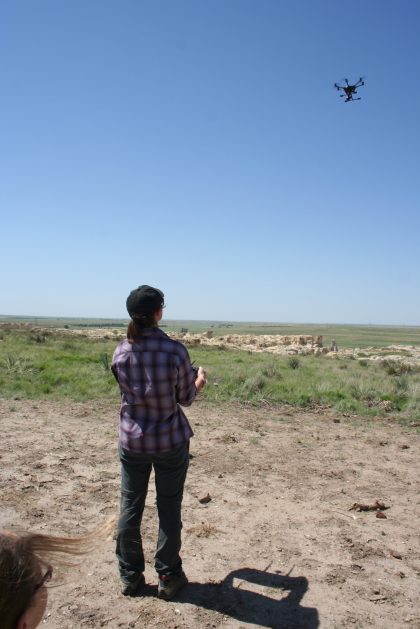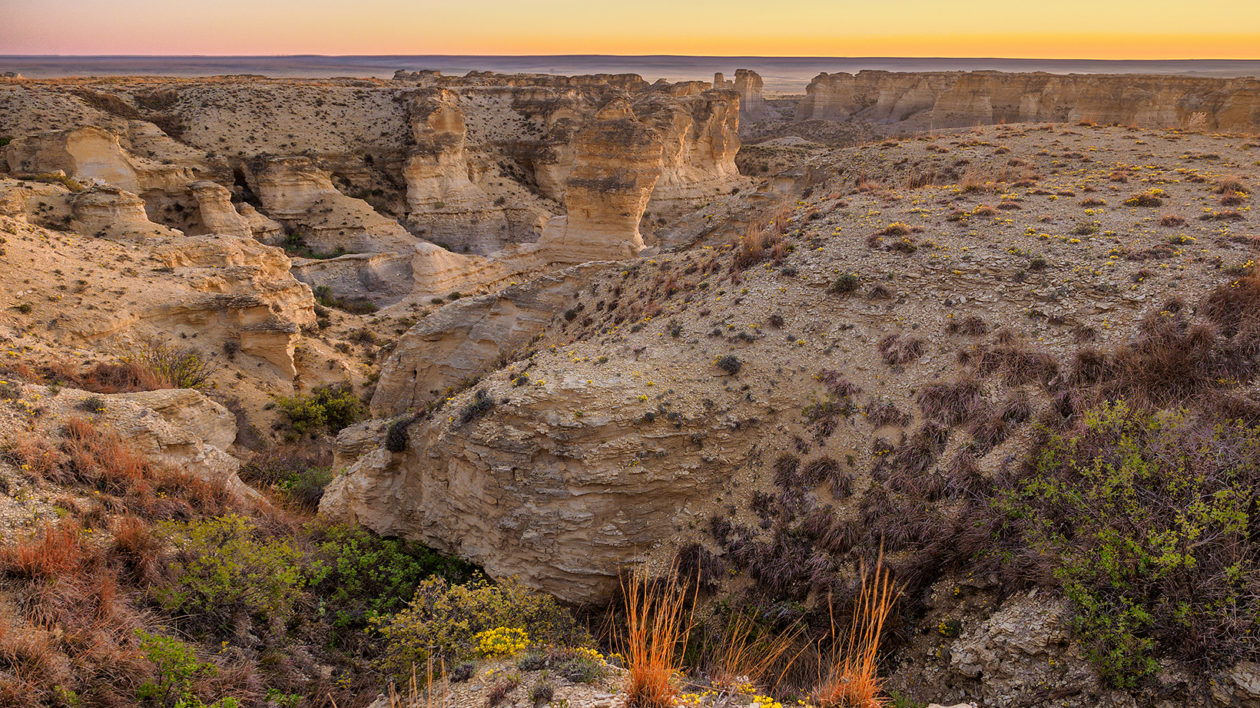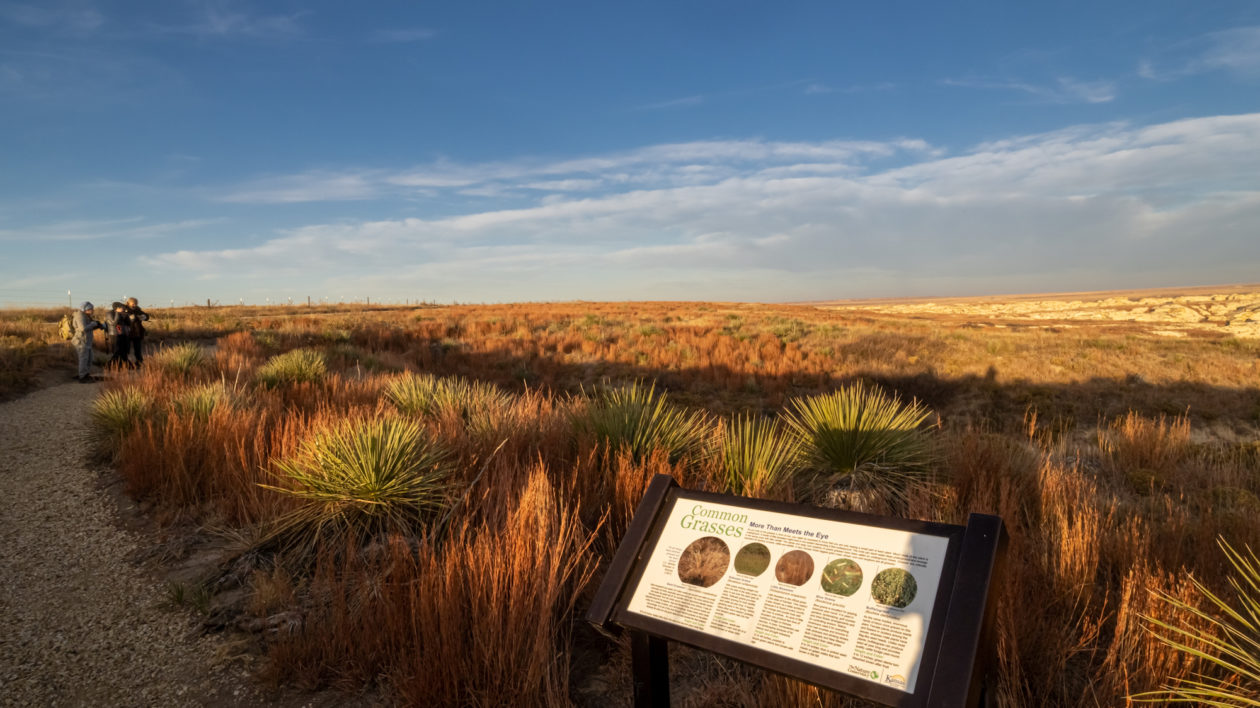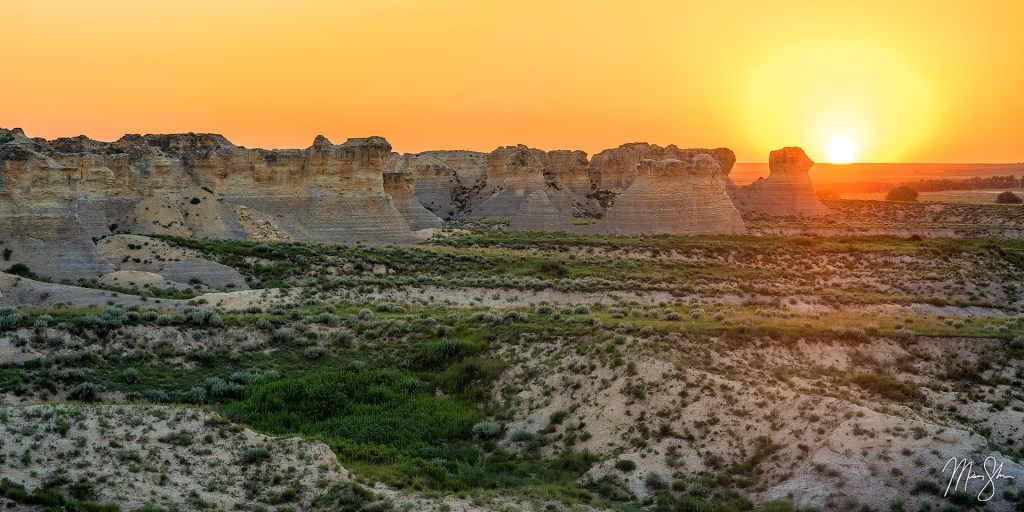Kristen Sikorsky remembers the first time she saw Little Jerusalem.
“It was like looking at a mini-Grand Canyon,” said Sikorsky, a Kansas State University graduate research assistant in the Park Management and Conservation Departments of Horticulture and Natural Resources.
A native of Rhode Island, she was used to seeing the ocean. And, although her K-State advisor, Ryan Sharp, had warned her, she was “blown away” by Little Jerusalem’s magnificence.
And although it’s in the middle of the western Kansas prairie, Little Jerusalem is also the remnant of an ocean that was formed nearly 63 million years ago.
“I was astounded by the amount of fossils and the geography of the place,” Sikorsky said. “What struck me was that I hadn’t ever seen chalk bluffs before. It looked like nothing else in Kansas. I’d never seen features quite that tall and pronounced on such flat surrounding landscapes. And, it struck me that this was something formed by weather over millions of years.
It’s been more than two months since the long-anticipated opening of Logan County’s Little Jerusalem Badlands State Park. The 332-acre park is owned by The Nature Conservancy (TNC) which partnered with the Kansas Department of Wildlife, Parks and Tourism (KDWPT) to maintain and run Kansas’ newest state park.
While the two organizations developed trails, parking, and infrastructure, Sikorsky researched and gathered data for work on her master’s thesis.

From Drones to Management Data
Sikorsky is conducting ecological research and document the property in a way that makes it a first, not only for Kansas but also for North America.
By using a program called the Inter-Agency Visitor-Use Management Framework, developed by the National Park Service and the U.S. Fish and Wildlife Service, she has been able to gather data that can be used to determine management actions for the Kansas park.
And, she’s done it through the use of drones and trail cameras.

“It was the perfect opportunity to explore the resources of this brand-new state park and pinpoint exactly how visitors would influence the overall ecology,” Sikorsky said. “So, using that framework, I wanted to apply it to a state park setting rather than a federal public land and see if we could stretch it a little further.”
And, because Kansas State University has an Applied Park Science Lab, she was able to use that to her advantage.
“The reason I wanted to come into park management and conservation is because I want to do work as a public servant,” Sikorsky said. “I have always had an urge to work for government and with the American public. Part of the wonderful thing about working as an ecologist and a social scientist is that you realize how important it is to get people to care for nature. If they can’t get out in nature and experience it themselves, they have no reason to truly care or put into stock what we are so lucky to have in the United States.”
In her research, she discovered just how frail chalk formations can be.
The Niobrara Chalk formations at Little Jerusalem are extremely fragile — enough so, they can lose up to two-inches a year in the natural rate of erosion, depending on rainfall. They are home to the nesting habitat for ferruginous hawks and rare plants.
“So, I was wondering what the plans were for the actual trails,” Sikorsky said. “What was the trail system going to be like? If it took people down into the rocks, we could see a heavily increased rate of erosion, which could totally eliminate the resource. So, that was my first concern.”

But then she learned about cattle.
“That land — which had been in private ownership before TNC purchased it — had been cattle grazing land for eight generations,” she said. “They had not kept the cattle out of the rocks, so these 1,000-pound animals had already been trafficking in and about the chalk. The more I thought about it, the less concerned I became with erosion.”
“In fact, it was so evident, they have left paths in the chalk and surrounding vegetation, I used those to hike the property.” And in that, Sikorsky discovered a hidden blessing — ready-made trails.
For the past 18 months, Sikorsky has used drones to fly over the property to establish thresholds and what the acceptable levels of impact would be. She looks especially for vegetation loss and visitor-created trails — the kind when people trespass or wander off the established trail system. It is a new method of monitoring parks.
She learned to fly the drone and has become an FAA licensed drone pilot. “I don’t want to disturb the wildlife,” she said, “especially the ferruginous hawks. I have to fly at an elevation where they won’t get disturbed.”
Drones, or unmanned aircraft vehicles, are not allowed at Little Jerusalem Badlands State Park, so Sikorsky obtained special authorization to fly her research drones.

The park, she said, is home to not only the hawks but coyotes, tons of reptiles—especially rattlesnakes and meadowlarks. “It is one of the only areas in Kansas where you can find both the eastern and western meadowlarks,” Sikorsky said. “Their song is absolutely beautiful.”
She takes countless photos and hopes that one day, black-footed ferrets from the neighboring Smoky Valley Ranch may venture onto the property.
She has discovered moments of bliss at the site. But there have also been some moments of frustration.
Two weeks after the park opened, a park visitor captured a video of two young men throwing rocks at each other and the formations. The video had more than 300 shares on Facebook.
“Unfortunately, any area where we allow visitors, we cannot 100 percent police it,” Sikorsky said. “A lot of it is just the goodwill of the visitor. As much as we want to believe people are good, it isn’t always the case. We are not going to keep that area as pristine as it was before the park opening. It is simply impossible.”

According to Steve Seibel, High Plains Regional Supervisor for KDWPT, if a person is caught destroying property at the site, it falls under Destructive Acts Regulation. It carries with it fines ranging from $25 to $300 in addition to court costs as much as $115.
Since the park opened in October, more than 2,600 people have visited the site. Most of those visitors have been respectful.
“I think it is going really well,” said Matt Bain, Western Kansas Conservation Program Manager at TNC. “Whenever we have had a nice day, there are people out there, enjoying the place. Fall and winter can be tricky with weather but it’s amazing how much regular use is out there. It’s not big crowds but it is a good, steady flow of folks.”
As far as the video, Bain said, “a lot of people saw that and said it was unacceptable. It is helpful that people shared that. Our partners and people that care found it unacceptable. They were very vocal about it. That, in itself, will make people think twice about doing that.”

Sikorsky will be finishing up her final semester at K-State this spring. TNC will continue monitoring the data at Little Jerusalem, and its possible more students from K-State continue the research.
“We are trying to understand the impacts and provide the parks and managers the resources to do long-term monitoring,” said Ryan Sharp, associate professor at K-State’s department of horticulture and natural resources park management and conservation program.
“Inherently, if one person takes a rock, it is not that big of a deal. But, if a million people take one rock, it is a big deal. What we are trying to do in our Applied Park Science Lab at K-State is balance the need for people to go outside and our desire to provide access to parks and protected areas.”
But more importantly, the promise of Little Jerusalem is that it offers visitors a chance to bring joy to the soul.
“At the end of the day, we are hopefully inspiring people to conserve what’s left of our native prairie out here,” Bain said. “I think it is working.”




What an excellent description and pictures at the park. Thanks.
I recently visited the site. They have wonderful trails around the upper perimeter of the site. What appears to be flat range land, suddenly opens up when you look down into these nearly invisible canyons. There are many, many spots to pause and take pictures of these marvelous, ancient formations. (And after your visit, Monument Rocks are only 10 miles away!)
Will have to find pictures. We were there back in the late 1960s or early 70s. Very worthwhile trip.
GREAT Work, Kris!.. Very Proud of the Research and Development You and KSU have done! One day, I hope to hike these Trails with my Children and Grandchildren!?
If anyone has questions about my data collection methods, analysis, or just the property itself, please feel free to reach out to me at KDSikorsky@ksu.edu or add my Linkedin. I’m always happy to talk about what I am so lucky to do out at Little Jerusalem.